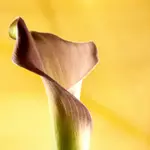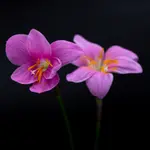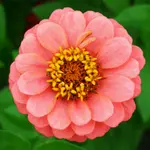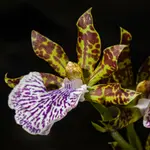Below is a list of flowers that start with the letter “Z”. We have focused on common and easy-to-grow varieties.
Flowers That Start With Z – List Of Flowers That Name Starts With the Letter ‘Z’

Zantedeschia
Southern Africa is home to the genus Zantedeschia, which is a member of the Araceae family. The genus contains eight species and a large number of cultivars of herbaceous perennials that fall into two main categories: the more tender Calla Lilies and the harder outdoor forms with striking white flowers and white spots on their leaves.

The widely used Zantedeschia plant is a lovely addition to any garden. These plants can be grown in water as well as in beds, borders, and containers (Zantedeschia aethiopica). Italian botanist Giovanni Zantedeschi (1773–1846) is remembered by the genus’s name.
The plant is frequently referred to as “Calla Lily.” The name “calla” (which means “beautiful” in Greek) is a misnomer because the plant is not a true lily. Famous Swedish botanist Carolus Linnaeus named the plant incorrectly. Although it was later corrected, the common name is still in use and still applicable today.
The calla lily represents death, but also resurrection and rebirth, as well as beauty, purity, integrity, faithfulness, and holiness.
The Greek word for “Calla” is “beauty,” so the name is ideal. This flower, which is well-known for its beauty, works well as a garden or home decoration.
Calla lilies are frequently used in wedding bouquets because they represent honesty and faithfulness. Due to their religious and mythological significance, they also stand for holiness. They are portrayed in Christian art as the Virgin Mary and Jesus Christ as a representation of holiness, resurrection, and rebirth.
These flowers are frequently chosen for a variety of occasions, including funerals, because of their exquisite appearance. They stand for death, but more significantly, they also represent the close connection between life and death.
Zephyranthes
The Amaryllidaceae family includes the genus Zephyranthes, which contains about 90 species of flowering plants, most of which are perennials. They are indigenous to South America, Central America, and the Southeast United States.

These plants have erect flower stalks that support a single flower with six or eight petals and grass-like foliage. The funnel-shaped flowers are more prevalent in the spring and summer. These lovely flowers come in a variety of colors from yellow to pink to white and can be placed in any garden. Some species have pleasant scents that bring joy and happiness to people.
The name of the genus is a combination of the Greek words “Zephyrus,” which refers to the god of the west wind, and “anthos,” which means “flower.” Because of its propensity to bloom following a rainstorm, the plant is more commonly referred to as “Rain Lily.” Because it frequently appears out of nowhere, it is also known as “Fairy Lily.”
The rain lily represents rebirth, fresh starts, and lofty goals.
These improbable flowers, which frequently bloom after rain, serve as a reminder that happiness is erratic and frequently lurks around the corner. As a result, they also represent joy and happiness.
The plants in question close at night and reopen in the morning. Nyctinasty is the behavior in question. Zephyranthes has been used to treat a number of illnesses, including viral infections, diabetes, tumors, cancer, headaches, coughs, and colds. This plant’s importance in the treatment of a variety of medical conditions is demonstrated by the fact that it is used to treat both minor health issues and serious diseases.
Zinnia
Asteraceae’s Zinnia genus includes about 20 species of annual and perennial plants that are primarily found in North America with a few species also occurring in South America. The most well-known species is the Mexican-born “Zinnia elegans.”

These simple-to-grow plants produce lovely, sizable mixed blooms in a variety of shades, hues, shapes, and sizes. Because it can draw both butterflies and birds, the plant is frequently grown in butterfly gardens. Johann Gottfried Zinn, a German botanist, is honored by the genus name (1727 – 1759).
Due to its stoic nature and prolonged bloom period during the summer, zinnia is a symbol of endurance. This is a tough beauty that can withstand difficult circumstances.
Additionally, it stands for love, enduring friendship, goodness, and memory. Zinnia will make a thoughtful and appreciated present for a birthday or anniversary.
Before, zinnia wasn’t as well known. Before it gained popularity, people thought it was small and ugly. They were called “mal de ojos,” which translates to “sickness of the eye” in Spanish, by the early Spanish explorers because they did not find them to be attractive. They returned to Europe in the 18th century with these “ugly” flowers. These lovely plants are currently among the most liked and well-liked garden plants!
From 1931 to 1957, Indiana, a US state, had zinnias as its official flower. The first flower to be raised in space, outside of the biosphere of the planet, is the zinnia. Images of a blooming Zinnia flower on board the International Space Station were made public by NASA in January 2016. (ISS). Zinnias are the first fully grown flowers in a NASA mission, even though they are not the first flowers on the ISS.
Scientists would gain a better understanding of how plants develop in microgravity by growing the Zinnias. The need to be able to grow plants becomes more urgent as humans travel farther and for longer distances from Earth, according to Gioia Massa, science lead for Veggie at NASA. In my opinion, plant systems will play a significant role in any long-term exploration scenario.
Zygopetalum
About 15 species of flowering plants in the Orchidaceae family belong to the genus Zygopetalum, which is indigenous to South America. These plants produce exotically patterned, waxy-looking blooms. The flowers have greenish-brown petals and sepals, purple lips, and a strong fragrance. Both terrestrial and epiphytic forms of these exotic orchids can be found, mostly in cooler high-altitude regions. They make excellent indoor plants that will give your house or office long-lasting interest and color.

The name of the genus, which refers to the intergrown, connected sepals and petals, is derived from the Greek words “zygon,” which means “yoke,” and “petalon,” which means “petal.”
Zygopetalum is a plant that represents spirituality and fertility. In general, orchids have a rich symbolic history.
Many species’ flowers have very strong scents that are very noticeable.
Zygopetalum in the wild uses its potent fragrance to entice pollinators, most of which are insects.
One of the biggest families of flowering plants, the Orchidaceae, includes Zygopetalum. A native of Brazil, Peru, Venezuela, and Columbia, it is a tropical orchid.
The first zygopetalums were discovered by Brazilian John Mackay. Sir William Hooker, a renowned orchid collector and expert, received plant material from John Mackay in 1827 and immediately came up with a new genus name for this orchid. It’s interesting that John Mackay’s name inspired the naming of the first Zygopetalum species, Zygopetalum mackayi. Many species’ flowers have very strong scents that are very noticeable. Zygopetalum in the wild uses its potent fragrance to entice pollinators, most of which are insects.